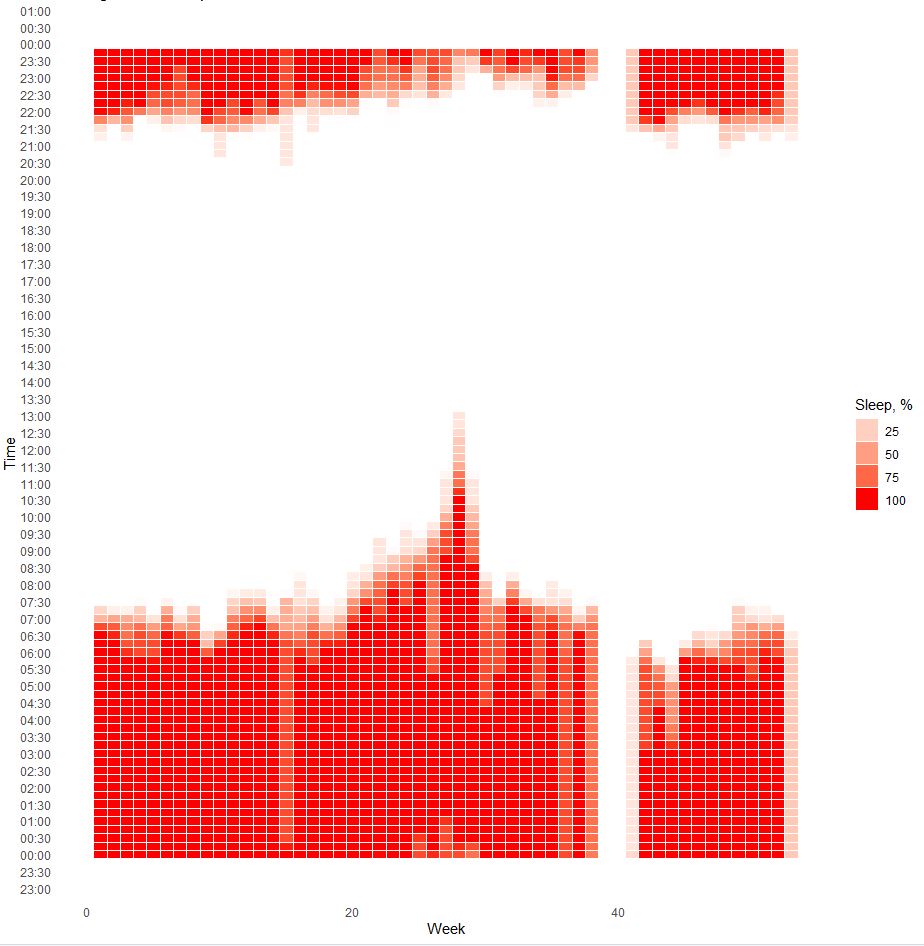Strict sleep schedule seems to be important to have lower sleep onset latency, better sleep quality and keeping our circadian clock in sync..There is good explanations of scientific background in a Why we sleep book by Matthew Walker.
Since i have detailed sleep tracking data, i can check what is my usual sleep schedule.
Heatmap of sleep status versus time fo day:

X - week number, Y - time of day, Color - % percentage of sleep per time period.
As we can see my usual bedtime start is between 22:00 and 22:45 and morning rise time is between 6:30 and 7:00. These timings confirms my constant sleep schedule. Acute increase in rising time at weeks 28-32 were due to COVID-19.
Data is available here.
library(lubridate)
library(dplyr)
library(plyr)
library(ggplot2)
#sleep status for 30 sec periods
df <- read.csv("https://blog.kto.to/uploads/sleep-status.csv")
df <- df[!is.na(df$`SleepStatus`),];
df$ymd <-ymd_hms(df$datetime)
df$date <-as.Date(df$ymd)
df$month <- month(df$datetime, label = TRUE)
df$year <- year(df$datetime)
df$day <- day(df$datetime)
df$week <- week(df$datetime)
df$wday <- wday(df$datetime, label = TRUE)
df$hour <- hour(df$datetime)
df$minute <- 60*60*df$hour + round(minute(df$datetime)/15)*15*60
df$time <- format(as.POSIXct('1900-1-1') + df$minute, '%H:%M:%S')
hdf <- ddply(df, c( "time", "week"), summarise, SleepStatus = 100*sum(SleepStatus)/(7*2*15))
hdf$x <- hdf$week
#hdf$x <- factor(hdf$month, levels=rev(levels(hdf$month)))
hdf$y <- as.POSIXct(strptime(hdf$time, format = "%H:%M:%S"))
hdf$f <- hdf$SleepStatus
library(scales)
ggplot(hdf, aes(x, y)) + geom_tile(aes(fill = f), colour = "white", na.rm = TRUE) +
scale_fill_gradient(low = "white", high = "red") +
guides(fill=guide_legend(title="Sleep, %")) +
scale_y_datetime(date_breaks = "30 min", date_labels = "%H:%M") +
theme_bw() + theme_minimal() +
labs(title = "Histogram of Sleep", x = "Week", y = "Time") +
theme(panel.grid.major = element_blank(), panel.grid.minor = element_blank())
Statistical analysis
RStudio version 1.3.959 and R version 4.0.2.